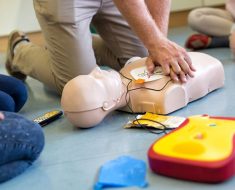
- Researchers are looking into the potential causes of cerebral small vessel disease by growing small blood vessel models in a lab.
- They said they hope to discover potential treatments for the condition, which can occur in people who have diseases such as high blood pressure and type 2 diabetes.
- Experts say the findings are promising, but they caution that the research still has a long ways to go.
Scientists at Cambridge University in England have grown small blood vessel-like models in the lab to find out what makes them leak in individuals with certain medical conditions that increase the risk of vascular dementia and stroke.
The results of that
There are two main types of cerebral small vessel disease (SVD).
The most common is associated with high blood pressure and type 2 diabetes and often occurs in middle-aged individuals.
The other rare form is inherited and usually found in people in their mid-30s. One cause is a mutation in a gene called COL4.
Details from the blood vessel and stroke study
In their study, scientists from the Victor Philip Dahdaleh Heart and Lung Research Institute at Cambridge took skin cells from people with the rare form of SVD that’s caused by mutations in the COL4 gene.
They used these to create induced pluripotent stem cells, which can develop into almost any cell in the body.
The researchers used these cells to form new cells and created a model of the disease found in the brain vessels.
The scientists reported that the mutations in this form of SVD caused disruptions in the
The scientists also found that too much production of molecules called matrix metalloproteinases (MMPs), which are needed to maintain the structure of the extracellular matrix, was associated with the disruption they observed.
The team treated the cells with drugs that inhibit MMPs. They used antibiotic doxycycline, the anti-cancer drug marimastat, or both to do this. The researchers said that inhibiting the MMPs with the drugs stopped the leaking and reversed the damage. However, they noted that these drugs can have serious side effects,
Where the research goes from here
“This is a basic research study focused on improving the understanding of the disease and identifying new targets to develop a novel therapeutic approach in the future,” Alessandra Granata, PhD, a senior research associate at Cambridge and an author of the study, told Medical News Today. “Thus, it does not directly impact the patients, but we hope it will in the future if we identify and/or develop drugs that work in our model and can be taken to clinical trial.”
“We are currently testing a panel of specific MMP (matrix metalloproteinases) that appear to contribute to the disease progression inhibitors provided by AstraZeneca as part of the OpenInnovation program in our in vitro model,” Granata added. “These inhibitors are for in vitro use only, but if they turned out to be effective in our system, they could be used to develop drugs that work in humans in the future.”
“We are also looking at different approaches to inhibit the MMP using RNA silencing technology, and we have already established a collaboration with Dr. Paul Holloway at Oxford University and Evox therapeutics,” Granata continued.” “The strength of our SVD models is that we can test these technologies in a fast and effective way in a relevant cell model, which could greatly expedite the development and discovery of new treatments for SVD.”
The scientists note that when new drugs become available, their model can be used to test them on SVD.
The information gleaned from this study can go beyond small cell disease, experts say. It helps to further the understanding of neurodegenerative diseases and vascular dementia.
“These research findings are interesting and have important implications for Neuroprotective strategies,” said Dr. José Morales, a vascular neurologist and neurointerventional surgeon at Pacific Neuroscience Institute in Santa California who was not involved in the study.
“The data provide evidence for the mechanisms underlying small vessel disease, neurodegenerative disease, and vascular dementia,” he told Medical News Today.
Some cautions about the SVD study
Dr. Sean Savitz, a professor and director of the Institute for Stroke and Cerebrovascular Diseases at UTHealth Houston, regularly treats people with SVD.
He told Medical News Today that he is impressed with the study findings but cautions that the scientists looked at cases that were rare genetic mutations.
“This is an elegant study that suggests some of the biological and molecular changes that might underlie the pathology we see in patients with small vessel disease (SVD) in the brain. SVD is very common, especially in older patients with vascular risk factors,” said Savitz, who was not involved in the study.
“Using skin cells to recapitulate the conditions in small vessel disease is very interesting,” he added. “It was exciting to see that a commonly used antibiotic could reverse some of the changes observed. However, we have to keep in mind that the cells were derived from patients with rare genetic mutations.”
What to know about cerebral small vessel disease
The researchers reported that SVD contributes to almost half (45%) of all dementia cases worldwide and about one-fifth of ischemic strokes.
These occur when a blood clot stops blood and oxygen flow to the brain. They are the most common type of stroke.
Cerebral small vessel disease is the most common, chronic, and progressive vascular disease, according to an article in
“SVD causes cognitive impairment, ischemic or hemorrhagic stroke, problems with mobility, and neuropsychiatric symptoms,” said Dr. Shae Datta, the co-director of NYU Langone’s Concussion Center in New York and director of cognitive neurology at NYU Langone Hospital—Long Island.
“Regular exercise, healthy diet, Mediterranean diet, folic acid, and vitamin B12 and avoiding adverse lifestyle factors such as smoking, excess alcohol or high dietary sodium, are all associated with having fewer SVD features in observational studies,” Datta, who was not involved in the study, told Medical News Today.
With SVD, there are usually multiple coexisting conditions, according to Dr. Catherine Arnold, a neurologist at Northwell Lenox Hill in New York who was not involved in the study. These can interfere with treatment.
“The results of this study allow a better understanding of some of the potential mechanisms behind the development of small vessel disease (SVD) and potential mechanisms for future treatments,” Arnold told Medical News Today.
“However, given the likelihood of multiple co-existing processes that contribute to the disease, this study alone does not provide enough clarity or insight to change practice entirely,” she added.
Treatments for SVD
“We would need to know in the future whether the findings apply to the majority of patients with cerebral small vessel disease associated with vascular risk factors such as hypertension and diabetes,” Savitz said. “Thus, we cannot immediately apply the information from these experiments to the clinical setting but the study paves the way for specific directions we should pursue in the future to develop treatments. Currently, we have no specific treatments aside from vascular risk factor modifications – controlling blood pressure, glucose, cholesterol and adhering to a healthy diet.”
Treatment often involves treating the underlying cause, such as practicing preventative strategies or treating an ischemic stroke.
“Secondary prevention measures typically include antithrombotics, glycemic control, antihypertensives, and statins, as well as promoting wellness, social connectedness, a Mediterranean diet, and regular exercise,” Morales said. “Compliance can often be an issue, in part due to medication side effects. Is it effective? Our current strategies are supported by evidence implying their effectiveness in mitigating some of the effects and progression of vascular disease, but there is undoubtedly a need for precision-based medical strategies that target these mechanistic pathways with more efficacy.”
Source: Read Full Article





